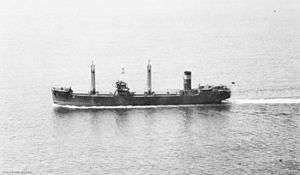SS Iron Knight (1937)
SS Iron Knight was a 4,812 GRT Australian iron ore carrier which was sunk during World War II by a Japanese submarine.
 | |
| History | |
|---|---|
| Owner: | BHP Shipping |
| Port of registry: |
|
| Builder: | Lithgows Ltd, Port Glasgow |
| Launched: | 1937 |
| Completed: | October 1937 |
| Identification: |
|
| Fate: | Torpedoed by Japanese submarine I-21 on 8 February 1943 |
| General characteristics | |
| Tonnage: | 4,812 GRT |
| Length: | 404 ft 5 in (123.27 m) |
| Beam: | 56 ft 2 in (17.12 m) |
| Depth: | 23 ft 2 in (7.06 m) |
| Propulsion: | 1 x quadruple expansion steam engine (David Rowan & Co, Glasgow) 553 hp (412 kW) |
| Complement: | 50 |
| Armament: | stern deck gun (3 or 4-inch) |
History
Iron Knight was built by Lithgows Ltd, Port Glasgow for Broken Hill Proprietary Company, Broken Hill. She was completed in October 1937 and was homeported in Melbourne under the British Flag.[1]
On 8 February 1943, Iron Knight was part of Convoy OC 68 from Whyalla, South Australia up the east coast of New South Wales to Newcastle, New South Wales.[2] At 2:30 am, a torpedo fired by Japanese submarine I-21 at escorts HMAS Townsville and HMAS Mildura passed under the bow of Townsville and struck Iron Knight, which was at the head of the convoy.[3] Her position was 36°31′S 150°23′E.[4]
Iron Knight sank, bow first, within two minutes. Out of the crew of 50 only 14 survived after climbing on board a single lifeboat, while the other 36 crew members' lives were claimed by Iron Knight's sinking. The convoy steamed ahead and the survivors were picked up by the French destroyer Le Triomphant ten hours later.[3]
The wreck of the Iron Knight was discovered in waters off the town of Bermagui, New South Wales at a depth of approximately 125 metres (410 ft). The wreck was officially declared a protected wreck on 4 August 2006.[3] The crew of Iron Knight who lost their lives in the attack are commemorated on the Newcastle Mercantile Marine Memorial, outside Newcastle railway station[5]
Official number and code letters
Official Numbers were a forerunner to IMO Numbers. Iron Knight had the UK Official Number 159568 and used the Code Letters VLJZ. [1]
References
- "LLOYD'S REGISTER, STEAMERS & MOTORSHIPS" (PDF). Plimsoll Ship Data. Retrieved 26 March 2009.
- "Broken Hill Proprietary". Mercantile Marine. Retrieved 26 March 2009.
- "The Final Journey of the Iron Knight" (PDF). New South Wales Government. Archived from the original (PDF) on 18 May 2009. Retrieved 26 March 2009.
- "LIST OF SHIPS INVOLVED IN SE ASIA". Children (and Families) of the Far East Prisoners of War. Retrieved 26 March 2009.
- "Newcastle Mercantile Marine Memorial". Register of War Memorials in New South Wales. Archived from the original on 21 July 2008. Retrieved 26 March 2009.